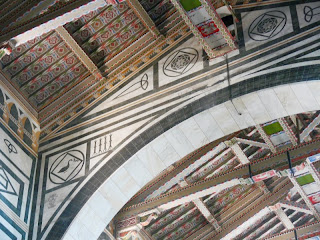The pedestrian zone doesn't have traffic lights, this picture was taken at the central bus and train station, where we went to get tickets for Venice, the subject of another posting or two no doubt! Also, the bus up to San Miniato was regular size, but I use what I get until truth gets in the way.
But our first try at going on the bus was San Miniato. You buy a ticket at a tobacco store (Tabacchi) and stamp it when you get on. Then go where you want and transfer when you want. If a ticket checker gets on and you don't have a ticket stamped in the last 90 minutes, you are in trouble.
San Miniato al Monte
This church is on top of a hill, just outside the old city. They have Gregorian Chant mass every evening at 5:30. Pat wrote about it, but, since I am elaborating ....
I haven't gotten around to looking it up yet, but I seem to remember something about Gregorian chants not using regular keys or measures -- they were written before that notation was invented. In any case, the music is hypnotic and/or entrancing. We are going to try to get more, either up at San Miniato or at one of the San Angelo artist masses at San Marco.
There is a great view of the city from up there. It is just a little higher than the Piazzale Michelangelo that every tour includes. The Piazzale has full size bronze copies of all Michelangelo's most famous statues.
The inside is very elaborate (the internet has lots about architecture and history of all these places.) The lower arch in this picture is a very fancy chapel that the Medicis had to build in the middle because somebody else built a very nice one off to the left side.
This is the giant mosaic at the rear, on a surface which is a quarter of a sphere. Byzantine I believe...
And this is the ceiling. The rafters and trusses are wood, but there is also this stone arch. It would be interesting to know how much of the geometric designs are just designs, and how much is symbolic of something. For instance, what is with the goose, or whatever, maybe a black swan? And the four stick figures beside it seem to vary from each other in ways that can't be random, given how precise everything else is.
S. Stefano al Ponte
This is the church across the street from us. Or actually, across the street and through an archway to Piazza Sant Stefano. The arch runs through a building. At one time in the middle ages, so many streets had buildings above them that torch street light had to be used even in daytime. Our street (Via Lambertesca) is supposed to be the most medieval street left. Maybe this is part of why. There is a similar arch going to the Ufizzi, and between them there are several narrow side streets, one of them about 6 feet wide.
It is just under 100 feet from our door to San Stefano. It turns out they have concerts every night, at least while we are here. Attendance has varied from 25 to 40. The concerts are only an hour long, but not very expensive. I am always amazed by the acoustics. One instrument, or one singer, fills the space. These two pictures show the front from top to bottom. The ceiling is about 70 feet up. We can look down at it from our terrace.
The capitals of the columns date from the first century. The whole place has been redone several times, most recently restored to medieval appearance.
There is also a carved Madonna and Child on the wall, identical to the one at Piazza del Limbo. This is attributed to Mino de Fiesole, about 1450. Mino did a lot of sculptures, enough that Piazza da Mino, the main square of Feisole, is named for him.
San Trinita
This is a couple of blocks down the street. It was built in the eleventh century, I believe, on the site of an older church, as most were. This view from inside of the entrance to the church shows some typical history.
At the front, the top of the stained glass window and the altarpiece are what I have called the old-style trinities. The blue glare streaks on the painting are because it is painted on wood panels, which are not quite flat.
Well, it is called S. Trinita. I am getting about tired of Trinities, and also of Annunciations, although they have a spectacular one here. Details of the principal characters:
I appreciate St. Joseph's reaction at seeing the crowd coming to visit the baby.
Ognissanti
This is where I took the picture of the Trinity that starts this whole blog. It turns out that that fresco is on the opposite side of the church from where I remembered, and it is attributed to Ridolfo Ghirlandaio, son of the man who did all the famous frescoes.
Here is the interior of this church.
This time, I noticed the following relief carving mounted on the wall. I don't read enough Italian except to figure out that it is a memorial to a woman. I'm not sure that it would be considered a Madonna and child, but even so, it is remarkable.
Other places and pictures
Telephoto view of mountain ridges, from San Miniato.
A shy statue at the British Consulate.
I started to take a picture of the flowers, and the composition just grew.
Seen while waiting for sunset on Ponte Vecchio.
The Pitti Palace courtyard. Note the people at the front door, for scale.























No comments:
Post a Comment